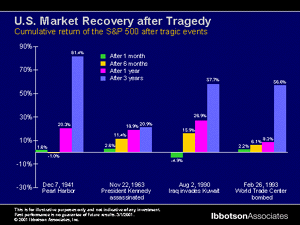 US MARKET RECOVERY AFTER TRAGEDY
After tragic events, US stock prices may initially drop, but they may gradually improve in subsequent months and years.
[ click to enlarge ]This image illustrates the cumulative return of stocks following four tragic events in American history. In the short-term, uncertainty from such external shocks may create sudden drops in value. For example, stocks had negative returns six months after the attack on Pearl Harbor. However, over a longer period of time such as 1 and 3 years, returns were positive. Fear and uncertainty may lead investors to sell their investments, putting downward pressure on prices. Trading on such emotions can be detrimental to a portfolio's value. By selling during downward price pressures, investors may realize short-term losses. Then, as they wait and hesitate to get back into the market, they may miss parts of the potential recovery. In the past, the United States has survived tragic events from the Pearl Harbor incident in 1941 to the bombing of World Trade Center in 1993. While stocks typically dropped in the first few months following the tragedies, they recovered in the long term. Note: This is for illustrative purposes only and not indicative of any investment. The data assumes reinvestment of all income and does not account for taxes or transaction costs. Returns and principal invested in stocks are not guaranteed. Stocks provide ownership in corporations that intend to provide growth and/or current income. Capital gains and dividends may be taxed in the year earned. An investment cannot be made directly in an index. Past performance is no guarantee of future results. Source: Stocks--Standard & Poor's 500, which is an unmanaged group of securities and considered to be representative of the stock market in general. | 







